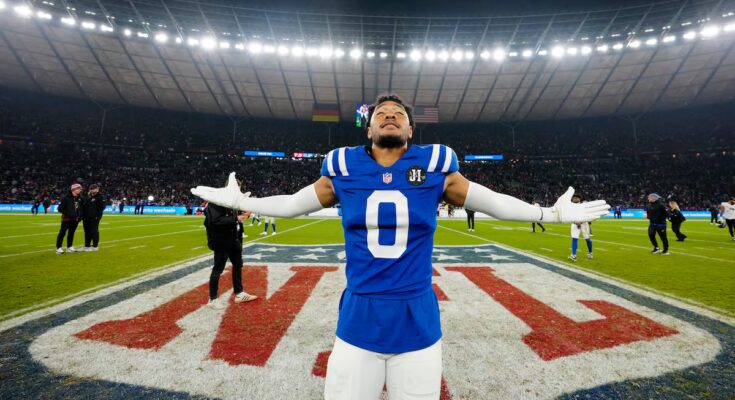The world of American football arrived in Spain as new territory to be conquered in a process of expansion that has seen NFL regular season games staged abroad for more than two decades. With London as their epicentre, franchises tested new markets, both in the Americas – mainly Canada, then Mexico and finally Brazil – and in Europe. After the successful experience in Germany, which began in Munich and arrived in Berlin last Sunday with the match between the Indianapolis Colts and the Atlanta Falcons, it is Madrid’s turn. The Spanish capital was chosen for its sporting culture, the quality of a stadium like Real Madrid’s Santiago Bernabéu and the visibility it offers to the Spanish-speaking public. For this reason, the Miami Dolphins have invested in holding one of their home games across the Atlantic, a precious resource for a competition that has just 17 games, excluding playoffs. The Nov. 16 game against the Washington Commanders is not only a contender for sporting event of the year in the capital city, but also marks the beginning of a long-term relationship that the NFL, in its search for fertile markets, anticipates.
While America’s major leagues in baseball, basketball and hockey have increasingly attracted foreign players over the 21st century, to the point of questioning the United States’ status as a superpower in their own games, American football lacks major international talent pools. Without ambassadors like Pau Gasol or Luka Dončić to conquer markets, the NFL has focused its expansion on taking its franchises around the world. What started as a casual game in Canada took on a global dimension in the 1990s, reaching countries such as the United Kingdom, Japan and Germany. Also included was Barcelona, which hosted the Los Angeles Raiders’ victory over the Denver Broncos on July 31, 1994 at the Estadi Olímpic. They were all friends, a concept that has lost its luster in the NFL as stars rarely risk injury during the preseason. The first regular season game was played in 2005 between the Arizona Cardinals and San Francisco 49ers at Azteca Stadium in Mexico, but London has become a fixture, an annual event that hosted four games in 2017. Most of the 32 franchises played at Wembley.
The NFL’s next step was to capitalize on Germany’s tradition as the European country most involved in the NFL Europe project after symbolic games such as the 1990 game at the Olympiastadion between the Los Angeles Rams and the Kansas City Chiefs, in what was then still West Germany. The NFL’s return to Berlin, 36 years after the fall of the Wall, comes after four games played in Munich and Frankfurt between 2022 and 2024. The league’s data shows 20 million NFL fans in Germany, its main base in Europe, compared to 11 million attributed to Spain, a very large statistical umbrella. The 11 franchises with commercial rights in Germany organized activities last weekend. In addition to the Dolphins, the Chicago Bears and Kansas City Chiefs, led by Patrick Mahomes, the great contemporary quarterback, have also shown interest in Spain.
Real Madrid concludes a 2025 program of seven international matches that began in Sao Paulo, continued in Dublin and kept the main focus on London with three events. “These games are real catalysts in their respective countries,” emphasizes Peter O’Reilly, NFL executive vice president in charge of international division. It guarantees “world-class entertainment”, like a “mini Super Bowl”, with a half-time show – Bizarrap and Daddy Yankee will perform in Madrid – and describes the Bernabéu as an “iconic” stadium. It also highlights the collaboration with the City of Madrid and the Region of Madrid. “Spain is a very important market for the NFL, not only for its rich sporting history, but also for its passionate fan base, which we want to continue to build on.” The opening of a permanent office in the country and the appointment of a coach from the league in Spain, Rafa de los Santos, is “a commitment to this market that could extend well beyond this first match”.
O’Reilly highlights the “incredible response” from the local public, including Spanish fans. “People often think of these games as people traveling from the United States, but the vast majority, about 90%, of the spectators are from the local market.” When choosing destinations, the NFL prioritizes the size and engagement of the local fan base, something it measures through previous events such as those held in Madrid and Berlin, as well as press and social media traffic. Added to this are the economic infrastructure – there are around 20 major sponsors for the Real Madrid match – and the financial stability of the stadium. “It’s a huge factor. When we were there during the renovation (of the Bernabéu), we were impressed by how they manage to maintain their incredible history in such a modern way. Real Madrid has been a great partner; it’s a great global brand.”
Now halfway through the season, the NFL boasts a stellar television product with 35 games (26% of the total) decided by a touchdown in the final two minutes, the most in its history. It is also recording its highest viewership in the first eight weeks of the regular season since 2015, following an annual growth rate of 7%. Next year, Rio de Janeiro and Melbourne will debut as host cities, with Melbourne hosting the first official match in Australia. The league plans to expand its schedule with two-year schedules; if Spain follows the German example, it could return in 2027. “Each market is unique. Spain is very important in its own right, but it also has that ‘halo effect’ of going beyond the boundaries of the Spanish-speaking world. We started with a base of 11 million viewers and our aim is to deepen that base,” explains O’Reilly, citing the London model as a point of reference. “We are seeing that the maturation process is even faster in Spain. This match will allow us to accelerate it.”
Sign up to our weekly newsletter to get more English-language news coverage from EL PAÍS USA Edition



